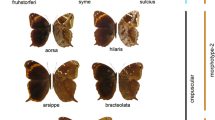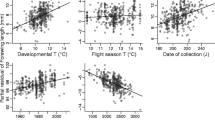Summary
The adaptive significance of alpine melanism, the tendancy for insects to become darker with increased elevation and latitude, was investigated using the butterfly Parnassius phoebus. The effects on temperature dependent activity of five components of overall wing melanism, as well as size, were examined. The components of wing melanism examined were the transparency of the basal hindwing and distal fore-wing areas, the width of the black patch in the basal hind-wing area and the proportion of black to white scales in that area, and the proportion of the distal fore-wing covered by predominantly black scaling.
The body temperature of dead specimens was correlated with air temperature, solar radiation, the width of the black patch at the base of the wings, and the proportion of black to white scales at the base of the wings. The minimum air temperatures and solar radiation levels required for initiation of flight did not vary with wing melanism of P. phoebus, in contrast to the results found for Colias butterflies by Roland (1982). However, under environmental conditions suitable for flight initiation, males with a higher proportion of black to white scales in the basal area of the hind-wing, and wider basal black patches, spent a greater proportion of time in flight at low air temperatures and low insolation. Increased basal wing melanism was also associated with increased movement of males within a population. In contrast, melanism in the distal area of the wings has no effect on activities which are dependant on body temperature. The amount of time spent feeding did not vary with differences in wing melanism. I suggest that in dorsal basking, slow-flying butterflies (Parnassius) basal wing color affects body temperature primarily during flight (rather than while basking), such that butterflies with darker wing bases cool down less rapidly because they absorb more solar radiation during flight.
Similar content being viewed by others
References
Baker RR (1968) A possible method of evolution of the migratory habit in butterflies. Phil Trans Roy Soc Lond B 253:309–341
Baker RR (1969) The evolution of the migratory habit in butterflies. J Anim Ecol 38:703–746
Beall G, Williams CB (1945) Geographic variation in the wing length of Danaus plexippus (Lep. Rhopalocera). Proc R Ent Soc Lond A 20:65–76
Benham BR, Lonsdale D, Muggleton J (1974) Is polymorphism in two-spot ladybird an example of non-industrial melanism? Nature 249:179–180
Bernstein C (1980) Density-dependent changes in sex ratio in Colias lesbia (Lepidoptera: Pieridae) Ecol Ent 5:105–110
Brussard PF, Ehrlich PR (1970) The population structure of Erebia epipsodea (Lepidoptera: Satyrinae). Ecology 51:119–129
Chaplin SB, Wells PH (1982) Energy reserves and metabolic expenditures of Monarch butterflies overwintering in southern California. Ecol Entomol 7:249–256
Clench HK (1966) Behavioral thermoregulation in butterflies. Ecology 4766:1021–1034
Clifford TJ (1981) A comparative study of three Colorado populations of Parnassius phoebus F. (Papilionidae). Univ Wyoming MSc thesis, p 105
Cook LM, Brower LP, Croze HJ (1967) The accuracy of a population estimation from multiple recapture data. J Anim Ecol 57–60
Douglas MM (1978) The behavioral and biophysical strategies of thermoregulation in temperate butterflies. Univ Kansas PhD thesis, p 323
Douglas MM, Grula JW (1978) Thermoregulatory adaptations allowing ecological range expansion by the Pierid butterfly Nathalis iole Boisduval. Evolution 32:776–783
Douwes P (1976) Activity in Heodes virgaurae (Lep., Lycaenidae) in relation to air temperature, solar radiation, and time of day. Oecologia (Berlin) 22:287–298
Downes JA (1964) Arctic insects and their environment. Can Ent 96:279–307
Downes JA (1965) Adaptations of insects in the arctic. Ann Rev Entomol 10:257–274
Ehrlich PR, Launer AE, Murphy DD (1984) Can sex ratio be defined or determined? The case of a population of checkerspot butterflies. Amer Nat 124:527–539
Ehrlich PR, White RR, Singer MC, McKecknie SW, Gilbert LE (1975) Checkerspot butterflies: A historical perspective. Science 188:221–228
Ferris CD (1976) A proposed revision of non-arctic Parnassius phoebus Fabricius in North America (Papilionidae). J Res Lepid 15:1–22
Freeman TN (1958) The distribution of arctic and subarctic butterflies. Proc 10th Internat Congr Ent 1:659–672
Gilbert LE, Singer MC (1975) Butterfly ecology. Ann Rev Ecol System 6:365–395
Guppy CS (1984) Alpine melanism in the butterfly Parnassius phoebus F. (Lepidoptera: Papilionidae). Univ British Columbia MSc thesis, p 159
Guppy CS (1986) Geographic variation in wing melanism of the butterfly Parnassius phoebus F. (Lepidoptera: Papilionidae). Can J Zool 64:956–962
Harrison RG (1980) Dispersal polymorphisms in insects. Ann Rev Ecol Syst 11:95–118
Heinrich B (1981) Insect Thermoregulation. John Whiley and Sons, New York
Hovanitz W (1941) Parallel ecogenotypical color variation in butterflies. Ecology 22:259–284
Hovanitz W (1950) The biology of Colias butterflies. I. The distribution of the North American species. Wasman J Biology 8:49–75
Jones RE, Hart JR, Bull GD (1982) Temperature, size, and egg production in the cabbage butterfly, Pieris rapae L.. Aust J Zool 30:223–232
Kammer AE (1970) Thoracic temperature, shivering, and flight in the Monarch butterfly, Danaus plexippus (L.). Z Vergl Physiologie 68:334–344
Kettlewell B (1973) The evolution of melanism. the study of a recurring necessity. Clarendon Press, Oxford
Kevan PG, Shorthouse JD (1970) Behavioural thermoregulation by high artic butterflies. Arctic 23:268–279
Kingsolver JG (1983a) Thermoregulation and flight in Colias butterflies: Elevational patterns and mechanistic limitations. Ecology 64:534–545
Kingsolver JG (1983b) Ecological significance of flight activity in Colias butterflies: Implications for reproductive strategy and population structure. Ecology 64:546–551
Kingsolver JG, Koehl MAR (1985) Aerodynamics, thermoregulation, and the evolution of insect wings: Differential scaling and evolutionary change. Evolution 39:488–504
Kingsolver JG, Moffat RJ (1982) Thermoregulation and the determinates of heat transfer in Colias butterflies. Oecologia (Berlin) 53:27–33
Kingsolver JG, Watt WB (1983) Thermoregulatory strategies in Colias butterflies: Thermal stress and the limits to adaptation in temporally varying environments. Am Nat 121:32–55
Mani MS (1962) Introduction to high altitude entomology. Insect life above the timberline in the north-west Himalaya. Methuen and Co Ltd, London
Mani MS (1968) Ecology and biogeography of high altitude insects. Dr W Junk NV Publishers, The Hague
Murphy DD, Launer AE, Ehrlich PR (1983) The role of adult feeding in egg production and population dynamics of the checkerspot butterfly Euphydryas editha. Oecologia (Berlin) 56:257–263
Murphy DD, Menninger MS, Ehrlich PR (1984) Nectar source distribution as a determinant of oviposition host species in Euphydryas chalcedona. Oecologia (Berlin) 62:269–271
Neville AC, Weis-Fogh T (1963) The effect of temperature on locust flight muscle. J Exp biol 40:111–121
Nielsen ET, Nielsen HT (1959) Temperatures preferred by the Pierid Ascia monuste L.. Ecology 40:181–185
Rainey RC (1974) Biometeorology and insect flight: Some aspects of energy exchange. Ann Rev Ent 19:407–439
Roff D (1977) Dispersal in Dipterans: Its costs and consequences. J Anim Ecol 46:443–456
Roland J (1978) Variation in spectral reflectance of alpine and arctic Colias (Lepidoptera: Pieridae). Can J Zool 56:1447–1453
Roland J (1982) Melanism and diel activity of alpine Colias (Lepidoptera: Pieridae). Oecologia (Berlin) 53:214–221
Shapiro AM (1970) The role of sexual behavior in density-related dispersal of Pierid butterflies. Amer Nat 104:367–372
Southwood TRE (1962) Migration of terrestrial arthropods in relation to habitat. Biol Rev 37:171–214
Vielmetter W (1958) Physiologie des Verhaltens zur Sonnenstrahlung bei dem Tagfalter Argynnis paphia L.-I. Untersuchungen im Freiland. J Insect Physiol 2:13–37
Watt WB (1968) Adaptive significance of pigment polymorphisms in Colias butterflies. I. Variation of melanin pigment in relation to thermoregulation. Evolution 22:437–458
Watt WB (1985) Bioenergetics and evolutionary genetics: Opportunities for new synthesis. Am Nat 125:118–143
Young AM (1982) Population biology of tropical insects. Plenum Press, N.Y.
Author information
Authors and Affiliations
Rights and permissions
About this article
Cite this article
Guppy, C.S. The adaptive significance of alpine melanism in the butterfly Parnassius phoebus F. (Lepidoptera: Papilionidae). Oecologia 70, 205–213 (1986). https://doi.org/10.1007/BF00379241
Received:
Issue Date:
DOI: https://doi.org/10.1007/BF00379241




